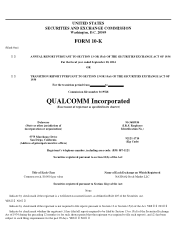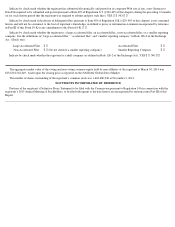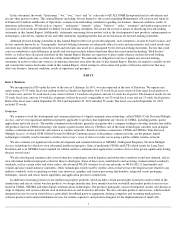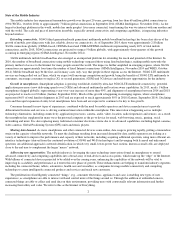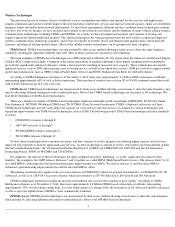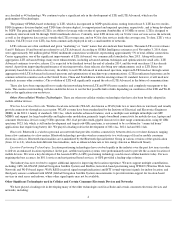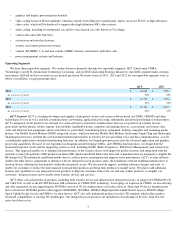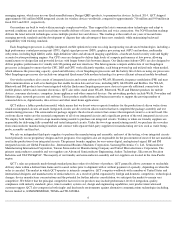Qualcomm 2014 Annual Report Download - page 12
Download and view the complete annual report
Please find page 12 of the 2014 Qualcomm annual report below. You can navigate through the pages in the report by either clicking on the pages listed below, or by using the keyword search tool below to find specific information within the annual report.
QCT’s current competitors include, but are not limited to, companies such as Broadcom, Ericsson, HiSilicon Technologies, Intel, Lantiq,
Marvell Technology, Maxim Integrated Products, MediaTek, nVidia, Realtek Semiconductor, Samsung Electronics, Spreadtrum
Communications (which is controlled by Tsinghua Unigroup), Texas Instruments and VIA Telecom. QCT also faces competition from products
internally developed by our customers, including some of our largest customers, and from some early-stage companies. Our competitors devote
significant amounts of their financial, technical and other resources to develop and market competitive products and, in some cases, to develop
and adopt competitive digital communication or signal processing technologies, and those efforts may materially and adversely affect us.
Although we have attained a significant position in the industry, many of our current and potential competitors may have advantages over us,
which include, among others: lower cost structures; better known brand names; ownership and control of manufacturing facilities and greater
expertise in manufacturing processes; motivation by our customers in certain circumstances to find alternate suppliers or choose alternate
technologies; foreign government support of other technologies or our competitors; more extensive relationships with local distribution and
original equipment manufacturer companies in emerging geographic regions (such as China); and/or a more established presence in certain
device markets.
QTL Segment. QTL grants licenses or otherwise provides rights to use portions of our intellectual property portfolio, which, among other
rights, includes certain patent rights essential to and/or useful in the manufacture and sale of certain wireless products, including, without
limitation, products implementing CDMA2000, WCDMA, CDMA TDD (including TD-SCDMA), GSM/GPRS/EDGE and/or OFDMA
(including LTE) standards and their derivatives. Our licensees manufacture wireless products, such as mobile devices, also known as subscriber
units, which include handsets, other consumer devices (e.g., tablets, laptops, e-readers, personal navigation devices), machine-to-machine
devices (e.g., telematics devices, meter reading devices) and plug-in end user data modem cards, certain embedded modules for incorporation
into end user products, the infrastructure equipment required to establish and operate a network, and equipment to test networks and subscriber
units. QTL licensing revenues are comprised of license fees as well as royalties based on worldwide sales by licensees of products incorporating
or using our intellectual property. License fees are fixed amounts paid in one or more installments. Royalties are generally based upon a
percentage of the wholesale (i.e., licensee’s) selling price of complete licensed products, net of certain permissible deductions (e.g., certain
shipping costs, packing costs, VAT, etc.). Revenues generated from royalties are subject to quarterly and annual fluctuations. The vast majority
of QTL revenues have been generated through our licensees’ sales of CDMA2000- and WCDMA-based products, such as feature phones and
smartphones.
Separate and apart from licensing manufacturers of wireless devices and network equipment, we have entered into certain arrangements
with competitors of our QCT segment, such as Broadcom, MediaTek, Texas Instruments and VIA Telecom. A principal purpose of these
arrangements is to provide our QCT segment and the counterparties certain freedom of operation with respect to each party’s integrated circuits
business. In every case, these agreements expressly reserve the right for QTL to seek royalties from the customers of such integrated circuit
suppliers with respect to such suppliers’ customers’ sales of CDMA-, WCDMA- and OFDMA-based wireless devices into which such suppliers’
integrated circuits are incorporated.
We face competition in the development of intellectual property for future generations of digital wireless communications technologies and
services. On a worldwide basis, we currently compete primarily with the GSM/GPRS/EDGE digital wireless communications technologies.
GSM has been utilized extensively in Europe, much of Asia, other than Japan and South Korea, and certain other countries. To date, GSM has
been more widely adopted than CDMA; however, CDMA technologies have been adopted for all 3G wireless systems. Most GSM operators
deployed GPRS, a packet data technology, as a 2G bridge technology, and a number of GSM operators deployed EDGE. However, the majority
of GSM operators have already augmented their networks with 3G WCDMA and HSPA. According to the Global mobile Suppliers Association
(GSA), as of October 2014, more than 330 wireless operators have commercially deployed and other wireless operators have started testing LTE,
a multi-carrier transmission technique based on OFDMA technology. According to GSA, more than 530 wireless operators have committed to
deploy LTE networks. We have invested in both the acquisition and development of OFDMA technology and intellectual property. Upon the
initial deployment of OFDMA-based networks, the products implementing such technologies generally are multimode and implement CDMA-
based technologies. The licenses granted under our existing CDMA license agreements generally cover multimode CDMA/OFDMA (3G/4G)
devices, and our licensees are obligated to pay royalties under their CDMA license agreements for such devices. Further, over 115 companies
(including LG, Microsoft, Samsung, Sony Mobile and ZTE) have royalty-bearing licenses under our patent portfolio for use in single-mode
OFDMA products (which do not implement any CDMA-based standards).
Since our founding in 1985, we have focused heavily on technology development and innovation. These efforts have resulted in a leading
intellectual property portfolio related to, among other things, wireless technology. We have an extensive portfolio of United States and foreign
patents, and we continue to pursue patent applications around the world. Our patents have broad coverage in many countries, including Brazil,
China, India, Japan, South Korea, Taiwan and countries in Europe and elsewhere. A substantial portion of our patents and patent applications
relate to digital wireless communications technologies, including patents that are essential or may be important to the commercial
implementation of CDMA2000, WCDMA (UMTS), TD-SCDMA, TD-CDMA (Time Division CDMA) and OFDMA products. Because all
commercially deployed forms of CDMA and their derivatives require the use of our patents, our patent portfolio is the most widely and
7


